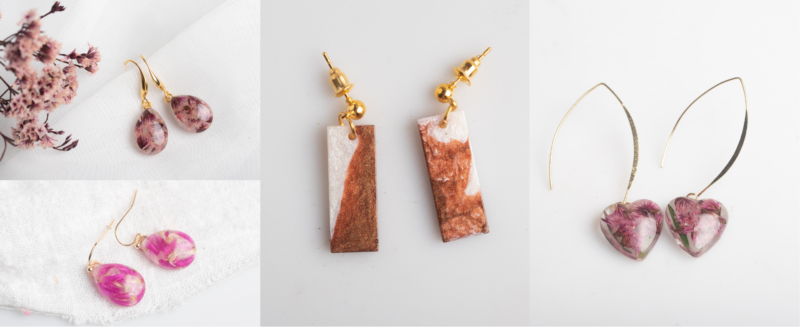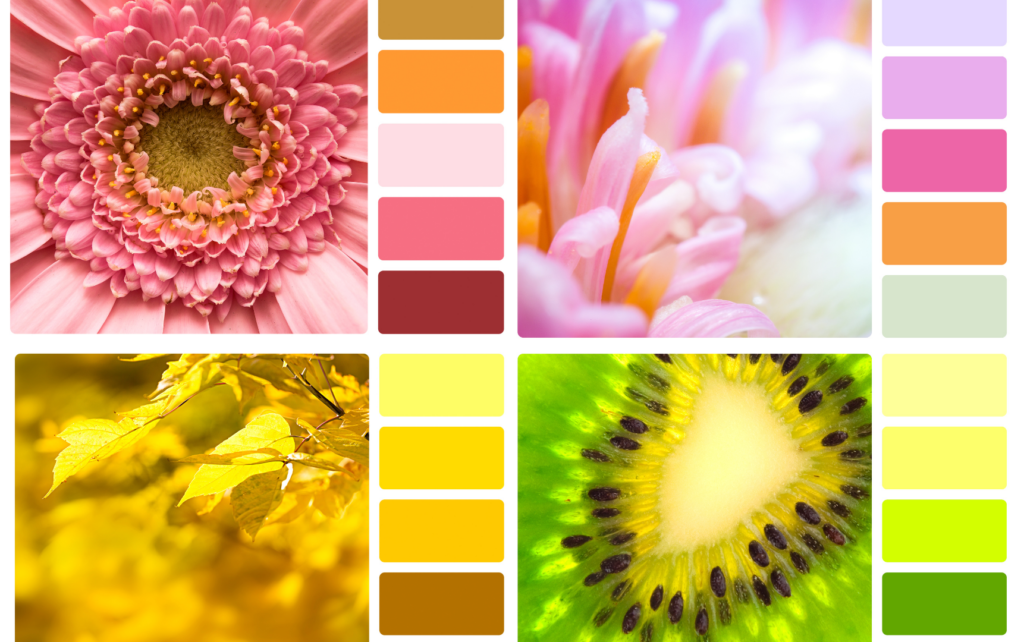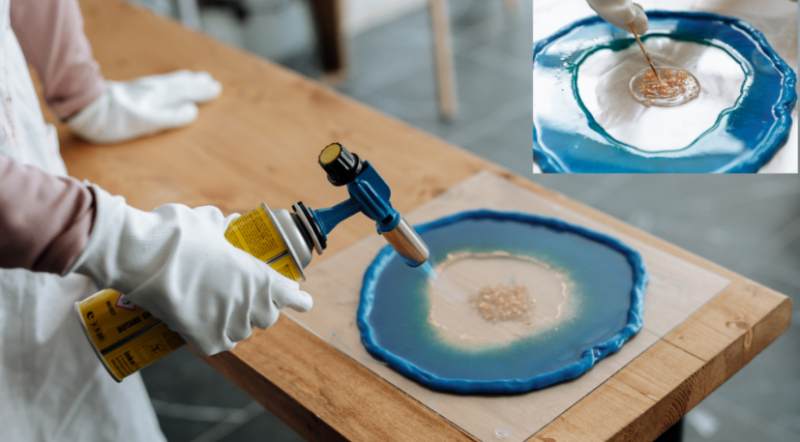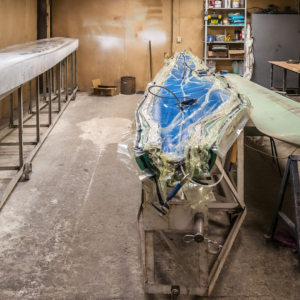Artists: Can Beginners Start Creating Jewellery with Epoxy?

Welcome to the captivating world of epoxy jewellery making! Discover your artistic potential with this comprehensive beginner’s guide. Take a creative journey into the world of exquisite jewellery crafted with epoxy!
What makes epoxy an ideal material for creating jewellery?
Epoxy, a versatile polymer, is a popular choice in the field of jewellery making. Its versatility, durability, and ease of handling make it a favourite among artisans. Comprising resin and hardener, this material undergoes a chemical reaction to create a rigid and robust final product. Epoxy offers vast creative possibilities. It can be poured into moulds or applied as a coating on surfaces like metal, wood, and plastic. Moreover, the availability of bio-based epoxy systems ensures sustainable and eco-friendly jewellery crafting.
The advantages of using epoxy in jewellery making are endless. This highly versatile material offers effortless tinting with vibrant colours and easy moulding into any desired shape, along with the option to adorn it with textures. These features allow artisans to create intricate and one-of-a-kind designs. Beyond aesthetics, epoxy boasts exceptional resistance to scratches, water, and UV rays. This makes it an excellent choice for crafting durable jewellery fit for daily wear and tear.
With a fundamental understanding of epoxy and its properties, artisans can unlock a world of infinite possibilities in jewellery making.
What are some creative design tips for crafting unique and beautiful epoxy jewellery?
1.Custom colour palette: Add pigments to the epoxy mixture to create a custom colour palette. By blending different pigment shades, you can produce a gradient or marbled effect that infuses depth and complexity into the design.
2.Texture and Individuality: Incorporate various textures and materials like glitter, beads, or dried flowers to elevate the design and add a touch of individuality.

Common Issues in Epoxy Jewellery Making and How to Troubleshoot Them
By exploring all these possibilities, you can curate epoxy jewellery pieces that accurately embody your personality and style.
While creating epoxy jewellery can be a rewarding experience, certain issues can arise during the process. One of the most common problems is the formation of bubbles in the epoxy mixture. This issue can be minimised by mixing the resin and hardener slowly and thoroughly and applying the mixture in thin layers. Using a heat gun or toothpick to remove any bubbles that form on the surface can also help. Inaccurate measurements, or insufficient mixing of the resin and hardener, can cause cracking or uneven surfaces. To avoid this, it’s important to follow the manufacturer’s instructions precisely and mix the components thoroughly. Sanding down uneven surfaces and polishing them can help create a smooth finish.
Applying the epoxy too thickly or not properly preparing the surface before application can result in cracks or uneven surfaces. It’s essential to sand the surface and apply a primer before applying the epoxy. If the mixed epoxy appears cloudy or discoloured, it may be due to improper mixing or out of life materials, and it’s best to discard the mixture and start fresh. Using high-performance epoxy systems, such as Entropy Resins® Clear Casting Resin, can result in stunning and durable epoxy jewellery pieces.
Tips for Polishing Your Epoxy Jewellery: How to Achieve a Professional Finish
Refining the final touches on your epoxy jewellery is a critical aspect that demands precision and attention to detail, along with the right set of tools. The sanding and polishing process plays a crucial role in achieving a smooth and professional finish. The process begins with using a fine-grit sandpaper to sand the surface of your jewellery piece, gradually moving to higher grits for a seamless and consistent finish. To achieve an even surface on flat areas, a sanding block can prove to be highly beneficial. Once you’re done with the sanding process, the next step is to apply a polishing compound and use a soft cloth or buffing wheel to bring out the brilliant shine of your jewellery piece. However, it’s important to apply the polish evenly and avoid over-polishing, as this can cause the resin to become thin or create uneven surfaces. By adopting the right techniques and using appropriate tools, you can elevate the appeal of your epoxy jewellery with a polished and professional look.
In conclusion, epoxy jewellery making is a captivating craft that merges creativity and science to produce dramatic and functional jewellery pieces. The advantages of using epoxy are extensive, including its versatility, durability, and ease of use, which make it an ideal material for both beginners and experienced artisans. We hope this guide has inspired you to delve deeper into the world of epoxy jewellery making, where the possibilities are truly limitless.

Examples of Epoxy Jewellery Handcrafted by a Skilled Artisan
Florine is a German artist who moved to France during the pandemic. She creates handmade jewellery and décor inspired by nature and botanical themes. She started her business, Fleur en Route Jewellery, during her six-month unemployment period after working with refugees for a year in 2017. Florine wanted to create her jewellery in an ethical and environmentally friendly manner and was drawn to epoxy and flower preservation techniques. She sells her products on Etsy and partners with local boutiques and concept stores in France. In the future, she plans to launch a local wedding bouquet preservation service.
Check out some of her impressive epoxy creations below…
You can find out more information about Florine on our meet the maker page here: https://epoxycraft.com/meet-the-maker/meet-the-maker-fleur-en-route-jewelry/
Where Can I Buy Epoxy?
Get ready to unleash your creativity in resin art or bring sustainability to your projects! Take the exciting step of ordering a set of bio-based epoxy from Entropy Resins.
Their high-quality products are not only eco-friendly, but also provide exceptional performance for all your epoxy needs. Give them a try and see what you can create. Please don’t hesitate to contact us and send any images of your creations. We would love to see what you’ve made.

Why is Entropy Resins a Preferred Choice for Jewellery Makers?
Entropy Resins has carved a niche for itself in the epoxy resin industry, thanks to its commitment to sustainability and performance. Their product range is ideal for various applications, including the creation of stunning jewellery.
What Sets Entropy Resins’ Colourants Apart?
Entropy Resins offers high-performance colourants that boast up to 98% bio-content. These colourants, when combined with Entropy Resins epoxy, are perfect for crafting eye-catching jewellery pieces. They offer a plethora of options, including translucent, opaque, and metallic colours.
How Can Translucent and Opaque Colours Enhance Your Jewellery Designs?
Entropy Resins’ translucent colourants are highly concentrated, ensuring longevity across multiple projects. They maintain absolute translucency, even at high loadings or in deep pours. Conversely, their opaque colours can render the epoxy completely opaque with just a few drops.
How Can Metallic Colours Add a Touch of Elegance to Your Jewellery?
Entropy Resins also offers metallic colours made with premium-grade mica powder. These metallic colours allow for an even distribution into the epoxy and won’t clump over time. They can be used to add a shimmering effect to your jewellery pieces.
What Safety Precautions Should You Take When Working with Epoxy or Entropy Colours?
When working with epoxy or Entropy Colours, it’s crucial to wear protective eyewear and gloves. It’s also recommended to mix a small batch of epoxy first, then add your colourant to achieve the desired colour. The ratio of epoxy to colourant, and the depth of your pour, will impact the resulting colour.
Why Should You Choose Entropy Resins for Your Jewellery Making Needs?
With Entropy Resins, the possibilities for creating unique and beautiful jewellery are limitless. Their range of high-performance colourants allows you to customise your epoxy, creating pieces that are not onl beautiful but also sustainable. Whether you’re an experienced jewellery maker or a novice, Entropy Resins has the products and advice you need to create stunning pieces of jewellery.



